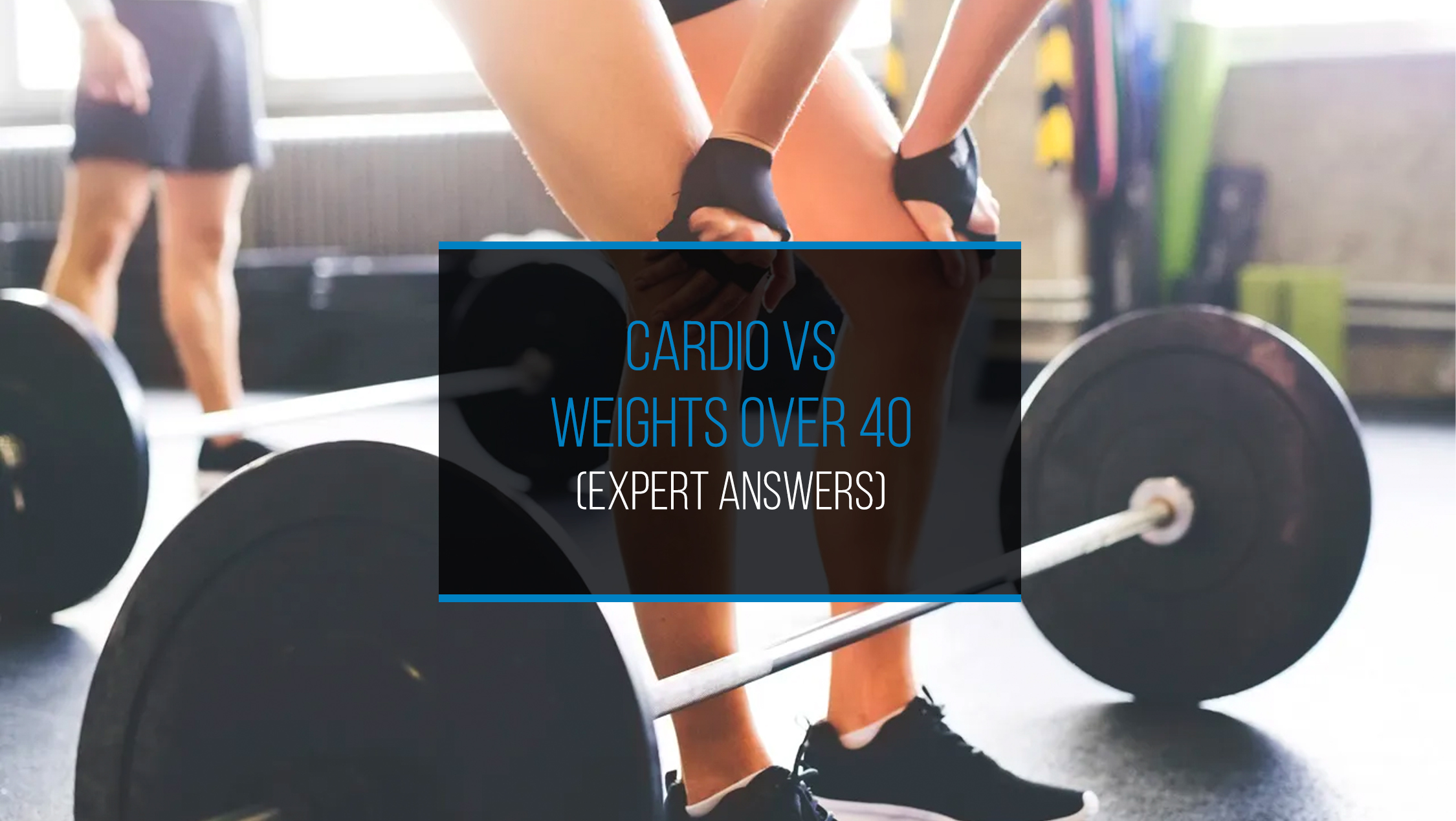Our bodies change as we age, and so can the type of exercise best for us. If you’re over 40, you might be wondering whether you need to change or adapt your current training — or you could be looking to implement a new, more suitable exercise routine.
But the question is, which is the best form of exercise when you’re over 40, cardio, weights, or a combination of the two?
In this article, we’ll compare both kinds of activity head-to-head based on expert opinion to find out which is best if you’re over 40. We’ll also discuss the best way to exercise and how to avoid injury or potential problems.
Should You Do Cardio & Weights Over 40?


Before comparing cardio and weights against each other, let’s first examine whether they’re good exercise choices if you’re over 40 — including the benefits and potential risks of each workout.
Is Cardio Good for the Over 40s?

Cardio is one of the best forms of exercise for the over 40s because of the potential health benefits you can get from performing regular aerobic exercise.
Here are just some reasons why cardio is an excellent form of exercise if you’re over 40:
- Cardio is a form of aerobic exercise that helps raise your heart rate, improves cardiovascular health, and increases lung capacity.
- If performed regularly, cardio can help reduce blood pressure, which can decrease the risk of heart attack.
- Cardio can help reduce the risk of type II diabetes, especially if it’s incorporated with a healthy diet.
- It can help burn calories, burn excess fat, and promote weight loss.
- Cardio can be done in short, sharp bursts or for more extended periods, making it versatile and suitable for all fitness levels.
- Cardio can increase your energy levels and boost your mood and well-being.
- It’s a great way to improve bone density and reduce the risk of osteoporosis.
Because so many kinds of activity can be considered cardio (providing it increases your heart rate to a certain level), it’s one of the most accessible and versatile forms of exercise.
Cardio exercise can include a range of activity, from HIIT sessions to yard work or running, depending on the kind of activity you enjoy most. You can also vary your cardio activity to make it more interesting and to prevent repetitive strain.
Potential Risks of Cardio Over 40
Although cardio exercise has many health benefits, it’s also essential to know the risks of training when you’re over 40 so you can exercise safely.
Below are a few things to keep in mind to help reduce the risk of injury:
- Start slowly. If you’re just starting cardio, don’t try to push too hard too soon, and begin with moderate activity while you build up your fitness levels.
- Don’t overdo things. Doing too much repetitive cardio activity can lead to fatigue or injury. Divide your exercise time into 30-minute sessions and make sure you have rest days.
- Make sure you warm up effectively. Don’t dive straight into exercise without warming up first, and consider pre- and post-workout stretches to reduce the risk of injury and increase mobility.
- Listen to your body. If something hurts or doesn’t feel right, take a break and get medical advice before you continue.
If you’ve not done cardio before or are starting again after a break, it’s a good idea to speak to a doctor or medical professional if you have any health concerns.
Should You Lift Weights if You’re Over 40?

You can definitely lift weights if you’re over 40. In fact, regular weight training is one of the best ways to get healthy and improve muscle strength as you age.
Below are just some of the benefits you can expect to see if you weight train regularly:
- Weight training can help improve your overall fitness levels.
- It can help reduce body fat and promote weight loss.
- Weight training can help reduce the risk of injuries in the future.
- Regular weight training can help make your joints stronger.
- Performing weight training regularly can help increase mobility and flexibility.
- Strengthening the muscles and improving mobility can help reduce the risk of injury.
Potential Risks of Weight Training Over 40
Regular weight training is an excellent way to maintain your strength and health as you age, but it’s essential to do it safely.
The list below shows some key points to be aware of when performing weight training over 40 and how to avoid potential injury:
- Don’t pile on the weight. If you’re new to weight training, start with lower weights and increase in time. Reps numbers are thought to be more important than weight, so there’s no need to pile it on too soon.
- Don’t overdo things. As with any exercise, it’s important not to overdo it and to take a rest day or do some cardio between workouts.
- Increase reps over time. Although it’s important to do enough reps to see benefits, if you’re just starting weight training, begin with a lower number of reps and increase over time.
- Vary your training. Focusing on different muscle groups not only helps strengthen the whole body, but it also helps prevent injury by not concentrating on the same area.
- Warm up & down properly. Warming up and down is key to preventing injury and pain and helps improve mobility and flexibility. Yoga or pilates stretches following a weight training session are becoming an increasingly popular way to warm down effectively.
- Listen to your body. If you feel pain or discomfort while weight training, there may be a problem that requires attention. Again, always consult a medical professional first if you have an existing health condition or any concerns.
Best for Heart Health

Winner: Cardio
As we age, it’s only natural that we want to focus more on heart health than we did in our younger years.
Cardio and weight training both help elevate heart rate, which in turn can provide a variety of health benefits, but of the two, cardio has the most potential to improve heart health.
Cardio is a form of repetitive exercise that elevates the heart rate, and providing intensity is maintained, it will remain elevated throughout the activity.
Cardiovascular benefits from regular cardio workouts include:
- Increased heart strength – helps pump blood more easily throughout the body.
- Reduced blood pressure – can help reduce the risk of heart attack and diseases.
- Reduces resting heart rate – improving the effectiveness of the heart.
This isn’t to say that weight training isn’t a good form of exercise for heart health because it can provide all of the benefits in the list above, but not always to the same extent as cardio.
Healthline says weight training can also help reduce bad LDL cholesterol and improve circulation by strengthening the heart and blood vessels.
If you’re over 40 and perform regular weight training sessions, it’s a good idea to alternate with some cardio to get the full benefits.
Best for Weight Loss and Fat Burning
Winner: Cardio
Cardio and weight training both help burn calories and body fat, which can help with weight loss, but the exercise with the potential to burn the most calories per session is cardio.
A person weighing 160lbs who runs at a moderate to fast pace for 30 minutes can expect to burn around 300 calories. In comparison, a weight training session of the same length burns up to about 220 calories.
It’s important to note that this also depends on the intensity of a workout and the types of exercises being performed. Training is also more effective at assisting with weight loss when you’re over 40 if combined with a healthy diet.
Although cardio helps burn more calories during exercise, weight training is a great way to increase metabolism. This happens because when you build muscle, the process helps your body to burn more calories at rest.
Best for Muscle Strength

Winner: Weight Training
Although some kinds of cardio work help build muscle strength, weight training is more effective in increasing strength because it uses greater resistance.
Some kinds of cardio exercises are better than others for increasing strength, however, most rely on body weight for resistance, so the muscle-building potential is more limited.
Cardio work such as running and cycling continually works the same muscle groups, so there’s more opportunity to strengthen all major muscle groups using weight training.
Menshealth confirms that there’s still excellent potential to build muscle in the 40s, although progress may be a little slower than it would have been in the decades before. However, it’s worth remembering that building muscle strength takes time to see results at any age — so patience is key.
Best for Joint Strength & Health
Winner: Weight Training
Increasing muscle strength can, in time, strengthen joints because the muscles help protect joints and connective tissues. Exercise also helps improve circulation around the joint, which helps keep them healthy.
The best form of exercise for joint health between cardio and weight training is weight training because there’s more opportunity to increase muscle strength and, therefore, joint strength.
Creaky Joints say that weight training is an excellent exercise for keeping joints strong and healthy, even if you have joint problems such as arthritis.
Although strength training is best for joint health, cardio is also good for maintaining joint health, especially lower-impact exercises like swimming and cycling.
Best for Mobility and Flexibility

Winner: Weight Training
Mobility and flexibility can be particularly important for those over 40 because it helps increase the range of exercise you can do and also helps prevent stiffness and injury.
The best way to increase mobility and flexibility between cardio and weight training is weight training. This is because there’s more opportunity for a greater range of movement and stretches while completing weight work than doing a repetitive cardio activity such as running.
Those who do regular weight training or cardio who want to improve flexibility and mobility often incorporate yoga or pilates into their weekly workouts.
Dynamic stretches, often used as warm-up stretches, are also an excellent way to increase flexibility, especially if they’re done after a session and focus on the same muscles used in the workout.
As well as increasing mobility and flexibility, dynamic stretches can also help increase blood flow around the muscles, prevent injury, and reduce pain following a workout.
Which is Best: Cardio or Weight Training?
We’ve now compared the potential benefits of each kind of exercise, so here are the results overall:
- Best for Heart Health: Cardio
- Best for Weight Loss and Fat Burning: Cardio
- Best for Strength: Weight Training
- Best for Joint Health: Weight Training
- Best for Flexibility and Mobility: Weight Training
On the face of it, it would appear that weight training comes with a wider range of benefits (which it does), but some of the most important benefits, such as heart health, come from cardio.
The truth is, the best exercise for those over 40 is a combination of cardio and weight training.
A combination of weight training and cardio is perfect for those over 40 because you get all the cardiovascular benefits of cardio with all the strengthening and mobility benefits of weight training.
The best way to incorporate cardio and strength training into your workout routine is to alternate them throughout the week — not forgetting a rest day or two.
Once you get into a routine of regular weight training and cardio sessions, you will see a range of benefits. As well as the ones discussed above, you will also see improvements in stability, coordination, and posture.
If you’re limited in time, there are many ways you can incorporate cardio workouts into your lifestyle without going to the gym, such as going for a quick run before work or a dance workout in the evenings. You can also do certain kinds of weight training at home (such as kettlebell), with limited space and equipment.
Ultimately, the kinds of exercises you choose will depend on what you enjoy most. When it comes to exercise, enjoyment is key, because if it becomes boring, we’re more likely to quit.

